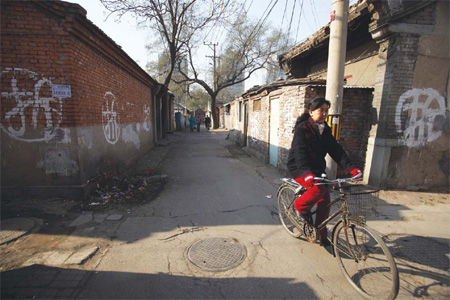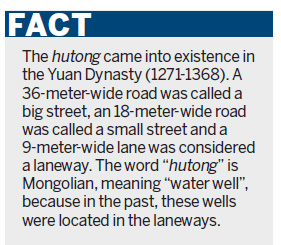Life and Leisure
Street fighters
(China Daily)
Updated: 2010-12-17 15:19
 |
Large Medium Small |
 |
|
About 1,000 hutong remain in Beijing and many have been saved, but |
Protests over hutong demolition force local governments to back down
Two elderly men chat in the middle of a small alleyway as they hold their songbird cages; a boy sits on a bench waiting for a haircut; a cobbler hunches over a pair of worn-out shoes, a group of pipe-smoking men circle around a checker board waiting for the next move.
And the smells of the neighbors' dinner waft through the air of this narrow hutong, or alleyway.
The maze-like hutong of Beijing have been bustling with life for centuries and news of their demise has been a common story over the past decade, as the capital transforms into one of the most important and modern metropolises in the world.
But the speed of their demolition this year has caused hot debate.
In 1949 there were 3,050 hutong in Beijing and by the late 1980s there were 2,250 as the capital expanded upwards as well as outwards, according to the Urban Planning Society of Beijing. Today, an estimated 1,000 remain.
Many Beijingers consider the remaining hutong as symbols of the old capital and are protesting strongly against any more demolitions. This month a local Beijing government showed it was listening.

Eighty-four-year-old Hou Changzhong is relieved his hutong neighborhood, in which he has lived for almost five decades, has been saved.
Since January, people living in Hou's neighborhood, known as Gulou (Drum Tower), have been anxiously counting down the days to move out after the Dongcheng district government announced major redevelopment plans.
The hutong area, which surrounds the city's famous Drum and Bell Towers, was to be turned into a tourist attraction called Beijing Time Cultural City, an underground complex comprising car parking lots, shops, restaurants and a museum.
At least five hutong neighborhoods were to be bulldozed and thousands of residents relocated.
The development plan triggered great debate and conservationists, concerned about the future of courtyard houses dating back to the Yuan Dynasty (1271-1368), lobbied the local government more than ever before.
"The removal of the surrounding hutong will undermine the historical and cultural landscape of the Bell Tower area, leaving us with only two ancient buildings and a discordant modern neighborhood," says Zhang Pei, project officer with the Beijing Cultural Heritage Protection Center.
She considers cultural heritage protection more than just looking after a few isolated landmarks, but also about protecting the neighborhoods around them because they are "closely related to each other".
Following the public outcry, Dongcheng district government announced on Dec 3 it would reduce the original construction plan by building only a museum and no additional hutong demolition was required.
Despite this recent victory, some locals still lament the loss of Beijing's past.
"The Xizhimen skyway is now standing on the site of my elementary school," says 27-year-old Lisa He, an English high school teacher.
"It was surrounded by more than 30 hutong and has now turned into a busy transportation hub surrounded by high-rise buildings and fancy department stores."
"I think foreigners come here to see the authentic old Beijing customs, not another Hong Kong or New York."
But not all Beijingers share the same sentiment and are proud of the modernization push.
"I lived in a hutong all my life with my parents and we crammed ourselves into a 10-square-meter room," says Chu Daye, 28, a website editor.
"It was very noisy and it was hard to concentrate when I was studying.
"Now we live in a 60-sq-m apartment, which is much better.
"But we live near the Fifth Ring Road and the new location is inconvenient compared to the old one because it was in the center of the city."
Some heritage experts particularly fear the demolition of courtyard houses and a city facelift that would be irreversible. "Beijing is bent on building a modern 'world city', but it is unwise to meet the goal at the cost of cultural and historical destruction," says Tang Yuyang, a professor with the Beijing University of Civil Engineering and Architecture.
"Hutong are the soul of Beijing and their construction cannot be repeated."
She suggests Beijing learn heritage lessons from European cities, such as London, Paris and Rome, all international metropolises with long histories. "Paris has made a conservation plan covering the whole city, in which 80 percent of Paris is under historic preservation. Any construction must be 'blended into the old environment'," she says.
It appears city authorities are responding. They released a report on Nov 4, saying that no major construction projects are planned for Beijing's old city area, referring to the area within the city's Second Ring Road.
The Beijing Municipal Commission of Urban Planning has issued a series of plans for the protection of the old city area in September 2009, highlighting the protection of traditional courtyard houses.
These courtyard homes, or siheyuan, which had not yet been listed as cultural relics but had typical characteristics of the Ming (1368-1644) and Qing (1644-1911) dynasties courtyards, are now protected. "These policies are signs of government progress," Tang says. "It shows that the government has come to realize the value of old community culture and accepts the voices from the public."
But she says it is hard for protective measures to always keep up with the pace of city development, and the protection of hutong in Beijing's outer suburbs may be overlooked.
"There must be ways to balance protection and development," Tang says, "otherwise, it is only empty talk unless government puts those written resolutions into practice."